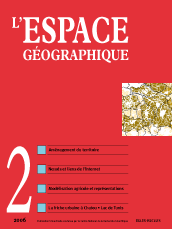

Nodes and links of the Internet: a geographical, economic and technical approach (9 fig., 3 tabl.)
This study, based on technical, economical, geographical and even historical parameters, seeks to explain the relationship between Internet networks and territorial development. The authors attempt to understand the complexity of the Internet through its links, nodes, crossroads and flows. They also identify the keys players in the Internet system and find that the geography of the net is concentrated in the triad countries. As a result, the authors highlight how technologies, actors’ strategies and territorial realities are relevant components in the geography of “cyberspace”.
keywords: BACKBONE, GEOGRAPHY, INTERNET, TERRITORIES
Territory at the centre of geography: a complex system (3 fig.)
Territory is the new buzzword, called on to provide solutions for socio-economic development or a coherent image of the places they encompass. The concept is extremely popular: everything is a “territory”, and concepts that reflect other realities tend to slip imperceptibly into that holdall. This paper therefore seeks to take a fresh look at the concept of territory from the angle of systems analysis in order to reach an operational definition that resituates territory in geographical space. Territory is thus put back at the centre of complexity.
keywords: ACTORS, GEOGRAPHICAL SPACE, SYSTEM, TERRITORY
The place and functions of farming in peri-urban mountain areas: periurban lifestyles and perceptions of rurality (1 fig., 3 tabl.)
The social values (such as “back to nature”) accompanying peri-urban development in the alpine corridor have the farming community wondering about their changing place and functions in local societies. With a view to responding to that concern, a survey of local residents was conducted and four resident profiles defined. These reflect a variety of perceptions of the living environment and farming. Alliances between farmers and residents are possible, but they require a shared view of local development issues. How can the farming community position itself when it no longer plays a central role in peri-urban areas or even in residents’ understanding of what is rural?
keywords: AGRICULTURE, ALPINE CORRIDOR, PERI-URBAN AREA, PLACE OF RESIDENCE, RESIDENT PROFILES, RURALITY
François CUQ. Modelling a farming activity with high environmental impact in a coastal zone (8 fig.)
A distributed artificial intelligence simulator was implemented in a context of coastal zone management. The model focuses on an intensive pig farm and its environmental impact in the Finistère department (Brittany, France). The above-ground production system was modelled in space and time according to environmental, climatic and regulatory constraints. Simulation results show that the recent tightening of regulations has reduced the annual balance of pig manure spreading. Conversely, the inclusion of climatic constraints in the new legislation has increased the variability of spreading and exposes the coastal zone to a significant risk of chronic pollution through intensive use of organic fertilisers.
keywords: AGRICULTURE, ARTIFICIAL INTELLIGENCE, COASTAL ZONE, FINISTÈRE, INTENSIVE PIG FARM
The ile de Chatou wasteland last frontier of the historical axis of Paris? (5 fig., 9 photos)
The persistence of wasteland on the northern end of the île de Chatou can be attributed to several factors. The combination of the changing role of the Seine in Paris, the contradictory aspirations of the neighbouring municipalities, and the structuring of western Paris by public planners has kept this land locked in a still virtual extension of the historical axis of Paris beyond the business district of La Défense. Some wastelands are thus not just intermediate spaces in transition from one use to another, because they are part of the dynamic structure of the urban form. The manufacture of the city does not conform to a model of growth in layers defined by the conglomeration of actors and their individual strategies.
keywords: HISTORICAL AXIS OF PARIS, ÎLE DE CHATOU, URBAN MORPHOGENESIS, URBAN WASTELAND
Globalisation, urbanity and new maritimity at the Lake of Tuni (3 fig., 3 photos)
This paper offers an interpretation of a new globalised public space located on the waterfront of a recently restored lagoon, which has become, in the space of just a few years, an ideal place for observing the changes in the societal system of Tunisia’s capital city. Interactions between citydwellers offer an opportunity to address practices and representations as a whole. This cross-cutting approach makes it possible to objectivise a double social reality: on the one hand, the lakeside appears to be a genuinely shared place, a concentrate of urbanity based on a set of values transgressing the normative system of customary public spaces of proximity, recognition and habits. On the other hand, the lakeside reveals new practices, which reflect a contemporary maritimity and are helping redefine the relationship between the residents of Tunis and their lagoon.
keywords: GLOBALISATION, MARITIMITY, PUBLIC SPACE, URBANITY
Book reviews
In this issue of l’Espace géographique, you will find critical reviews of the following books
BORDEN I., KERR J. RENDELL J., PIVARO A., ed. (2002). The Unknown City: contesting architecture and social space. Cambridge, Massachusetts: MIT Press, 540 p. (Hugh Clout, University College London)
POTTER R.B., BINNS T., ELLIOTT J.A., SMITH D. (2004). Geographies of Development. Harlow: Pearson Prentice Hall, 510 p. (Hugh Clout, University College London)
RIVIÈRE F. (1996). L’Italie et l’Europe, vues de Rome: le chassé-croisé des politiques régionales. Paris: L’Harmattan, 350 p. (Sébastien Velut, ENS Paris)
RIVIÈRE F. (2004). L’Italie, des régions à l’Europe. Paris: Armand Colin, 252 p. (Sébastien Velut, ENS Paris)
ROBINSON G. (2004). Geographies of Agriculture: globalisation, restructuring and sustainability. Harlow: Pearson Prentice Hall, 332 p. (Hugh Clout, University College London)
WALTER F. (2004). Les Figures paysagères de la nation. Paris: EHESS, 521 p. (Bernard Debarbieux, université de Genève)
L’espace géographique 1/06![]()
![]() L’espace géographique 3/06
L’espace géographique 3/06
For subscribe or buy this issue: BELIN
![]() L’Espace géographique: contents
L’Espace géographique: contents
Last modified: July 4, 2006